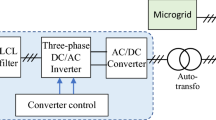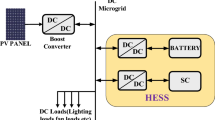Abstract
In South Korea, existing diesel generators are being replaced with photovoltaic (PV) generators in several standalone microgrids. However, their reliability and stability are still not guaranteed owing to PV fluctuations arising from unpredictable environmental changes. To reduce the effects of PV fluctuations, an energy storage system (ESS) with a similar capacity is needed to increase renewable energy sources (RES). A large-capacity ESS can be used as a main power source without a diesel generator when the state of charge is sufficient. In this study, a new method is proposed to mitigate the transients caused by the transition of an ESS to constant voltage constant frequency (CVCF) mode as a diesel generator is disconnected from a standalone microgrid. Existing PI controllers cannot completely suppress transients; hence, an adaptive sliding mode control (ASMC) method is applied to achieve a seamless transition. The transient effects of changing modes are analyzed, and the influencing factors are derived. Case studies on a practical standalone microgrid in South Korea are conducted through a time-domain simulation using DIgSILENT PowerFactory® software.











Similar content being viewed by others
References
Wang T, O’Neill D, Kamath H (2015) Dynamic control and optimization of distributed energy resources in a microgrid. IEEE Trans Smart Grid 6:2884–2894
Wu D, Tang F, Dragicevic T, Vasquez JC, Guerrero JM (2015) A control architecture to coordinate renewable energy sources and energy storage systems in islanded microgrids. IEEE Trans Smart Grid 6:1156–1166
Roposki B, Sen PK, Malmedal K (2013) Optimum sizing and placement of distributed and renewable energy sources in electric power distribution systems. IEEE Trans Ind Appl 49:2741–2752
Joung K, Lee H, Park J (2019) Assessment of maximum penetration capacity of photovoltaic generator considering frequency stability in practical stand-alone microgrid. Energies 12:1445
Ochs D, Mirafzal B, Sotoodeh P (2014) A method of seamless transitions between grid-tied and stand-alone modes of operation for utility-interactive three-phase inverters. IEEE Trans Ind App 50:1934–1941
Li X, Zhang H, Shadmand M, Balog R (2019) Model predictive control of a voltage-source inverter with seamless transition between islanded and grid-connected operations. IEEE Trans Ind Electron 64:7906–7918
Kleftakis V, Lagos D, Papadimitriou C, Hatziargyriou N (2019) Seamless transition between interconnected and islanded operation of DC microgrids. IEEE Trans Smart Grid 10:248–256
Slotine J, Sastry S (1983) Tracking control of non-linear systems using sliding surfaces, with application to robot manipulators. Int J Control 28:465–492
Utkin V (1993) Sliding mode control design principles and applications to electric drives. IEEE Trans Ind Electron 30:23–36
Zhuo G (2016) Robust sliding mode control of permanent magnet synchronous generator-based wind energy conversion systems. Sustainability 8:1265
Lee H, Utkin VI (2007) Chattering suppression methods in sliding mode control systems. Ann Rev Control 31:179–188
Utkin VI (1978) Sliding modes and their application in variable structure systems. Mir Publishers, Moscow
Utkin VI, Guldner J, Shi J (1999) Sliding mode control in electro- mechanical systems. Taylor and Francis Zhil’cov, London
Goldfarb LS (1999) On the theory of vibrational regulators. Automat Remote Control IX(6):413–431
Baek J, Jin M, Han S (2016) A new adaptive sliding-mode control scheme for application to robot manipulators. IEEE Trans Ind Electron 63:3628–3637
Ertugrul M, Kaynak O (2000) Neuro sliding mode control of robotic manipulators. Mechatronics 10:239–263
Yu X, Kaynak O (2009) Sliding-mode control with soft computing: a survey. IEEE Trans Ind Electron 56:3275–3285
Nagarale R, Patre B (2013) Neural-fuzzy sliding mode control of non-linear systems. Int J Adv Mechatronic Syst 5:209–219
Drigas A, Argyri K, Vrettaros J (2009) Decade review (1999–2009): progress of application of artificial intelligence tools in student diagnosis. Int J Soc Human Comput 1:175–191
Tseng M, Chen M (2010) Chattering reduction of sliding mode control by low-pass filtering the control signal. Asian J Control 12:392–398
Di Gennaro S, Domínguez J, Meza M (2013) Sensorless high order sliding mode control of induction motors with core loss. IEEE Trans Ind Electron 61:2678–2689
Levant A (2007) Principles of 2-sliding mode design. Automatica 43:576–586
Huang Y, Kuo T, Chang S (2008) Adaptive sliding-mode control for nonlinearsystems with uncertain parameters. IEEE Trans Syst Man Cybernet Part B Cybernet 38:534–539
Neila M, Tarak D (2011) Adaptive terminal sliding mode control for rigid robotic manipulators. Int J Automat Comput 8:215–220
Acknowledgements
This work was supported by the New & Renewable Energy of the Korea Insitute of Energy Technology Evaluation and Planning(KETEP) grant funded by the Korea government Ministry of Knowledge Economy (No. 20203040010240). This research was supported by the MSIT(Ministry of Science and ICT), Korea, under the Grand Information Technology Research Center support program (IITP-2022-2020-0-01612) supervised by the IITP(Institute for Information & communications Technology Planning & Evaluation).
Author information
Authors and Affiliations
Corresponding author
Additional information
Publisher's Note
Springer Nature remains neutral with regard to jurisdictional claims in published maps and institutional affiliations.
Rights and permissions
Springer Nature or its licensor (e.g. a society or other partner) holds exclusive rights to this article under a publishing agreement with the author(s) or other rightsholder(s); author self-archiving of the accepted manuscript version of this article is solely governed by the terms of such publishing agreement and applicable law.
About this article
Cite this article
Lee, HJ., Park, B.Y. Adaptive CVCF controller design for an energy storage system considering an operation mode change in a standalone microgrid. J Supercomput 79, 10849–10863 (2023). https://doi.org/10.1007/s11227-022-04953-y
Accepted:
Published:
Issue Date:
DOI: https://doi.org/10.1007/s11227-022-04953-y




